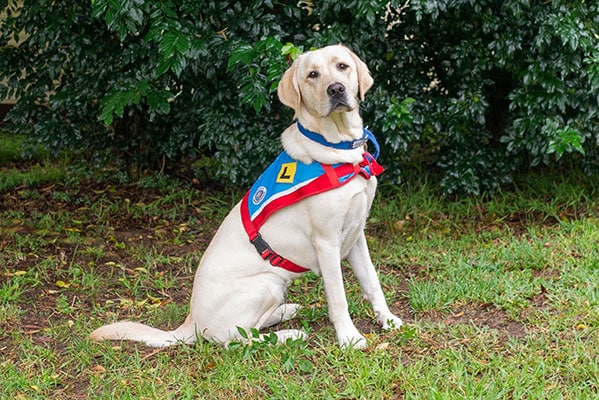Have you heard of a dog PAT test or PAT certificate for a Service Dog? This is a nationwide test that all Guide Dogs, Hearing Dogs and Assistance Dogs must pass to be official service animals.
The PAT certificate shows that a dog:
- Is safe and effective in public, vehicles, or places of accommodation
- Can be physically controlled by their primary handler or the primary handler with support of an alternative handler
If you have a dog that shows promise and you’d like to get them a PAT certificate, here’s what you need to know.

What is a PAT test?
First off, the term PAT test is actually not completely correct, since PAT stands for Public Access Test. So, when you say ‘PAT test’ you’re effectively saying Public Access Test test. However, this is the way it’s usually referred to – so we’ll continue using that term in this article.
A dog PAT test is basically a test they must pass to be certified a Service Dog under the Guide, Hearing and Assistance Dogs Act 2009. The test is done by Guide Dogs, Hearing Dogs and Assistance Dogs Australia.
Dogs who have passed the PAT test can help humans with physical, mental and intellectual challenges. Assisting people with significant mobility issues and eyesight issues are the more widely known reasons. However, such dogs also offer aid to persons with autism, Post Traumatic Stress Disorder (PTSD), epilepsy or seizures. You can read more about Assistance Dog types here.
Check out this video by our partners Assistance Dogs Australia to see how this Service Dog called Charlie is helping his owner, Matthew Connor, cope with PTSD:
Training for a dog PAT test
If you want to train your Guide, Hearing or Assistance dog, you must use an approved trainer or training institution. They’ll be able to take you and your dog through the dog PAT test and get them certified.
Here are two resources that will help you find an organisation that suits you:
- Assistance Dogs International directory for providers across Australia
- QLD government directory for providers across Australia
What does the PAT test require?
Potential Service Dogs must demonstrate their adeptness with the following tasks, which can be instructed through hand or voice commands:
Controlled exit of a car
The dog waits for their owner’s command before getting out of the car, then waits for further instructions.
Approaching a building
The dog starts walking to the building on their owner’s command. It does not become distracted by traffic, noise, or other stimulus. The dog stops when the owner stops.
Controlled entry
The dog calmly walks inside with its owner and stops when the owner stops.
Heeling through a building
The dog walks no more than 30cm from the owner and is able to adjust to changes in speeds and turning quickly.

Recall on lead
The owner should be able to move up to 2m away from the dog, and the dog will return when called.
Sits on command
The dog must sit on its owner’s command.
Downs on command
After sitting, food will be dropped on the floor. The dog isn’t allowed to pick up the food or sniff it. Then, another ‘down’ is called, and an adult or child approaches the dog. The dog should remain in its position and not seek attention.
Noise distraction
The dog should be aware of noises nearby, but not show any anxiety or aggression.
Off lead
The owner can walk with the dog without a lead.
Controlled unit
Lastly, on exiting the building, the dog shouldn’t show any anxiety or aggression at the sound of cars or a change in scenery.
The soon-to-be Service Dog must also fit the following criteria:
- Have completed a PAT test administered by an accredited trainer or training facility within seven days after certification and before applying for a handler identity card.
- Not be considered a restricted breed under the Animal Mismanagement (Cats and Dogs) Act of 2008.
- Be de-sexed, vaccinated, and not classified as dangerous dogs by local legislation.
Check out Bunjee’s performance in this video from Assistance Dogs Australia:
Dog PAT test FAQ
People have many questions about getting their dog a PAT certificate. Here are some commonly asked ones:
Where can my dog take the PAT test?
Only recognised organisations and approved independent public access test assessors are able to conduct a PAT test that has a valid certification. Organisations currently include:
- Assistance Dogs Australia
- Lions Hearing Dogs
- Seeing Eye Dogs Australia
- Royal Guide Dogs Association of Australia and affiliated bodies
How long does a PAT test certificate last?
Lastly, you’ll need to know how long the PAT certificate is valid. Once a dog receives a full two-year approval, the handler can renew the certificate every two years. This will require the submission of a renewal form. Plus, the dog will need to re-complete the PAT test to demonstrate it’s still safe to be taken into public areas.

Insurance for your Service Dog
Blue Badge Insurance understands the important role animals play in our lives – especially when we’re living with a disability. We offer healthcare coverage for your pup, whether they’re an Assistance Dog or a companion animal.
Check out our pet insurance and Assistance Dog insurance packages today.








